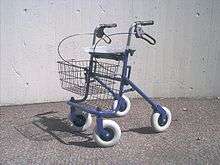Aina Wifalk
Aina Wifalk (21 March 1928 – 16 June 1983) was a Swedish social scientist and inventor of the modern walker.
| Aina Wifalk | |
|---|---|
| Born | 21 March 1928 |
| Died | 16 June 1983 |
| Occupation | Inventor |
Life and work
Wifalk was born in Lund, Sweden on March 21, 1928. In 1949, during her apprenticeship as a nurse, she fell ill with poliomyelitis at the age of 21. The illness forced Wifalk to end her apprenticeship. From then on she campaigned for people with disabilities. In 1952 she founded a club for the physically disabled in her hometown Lund, in 1958 an association for patients with multiple sclerosis in the Västmanland region and in 1968 the National Association for Accident Victims in Västerås.
After her aborted education, she studied social sciences. From 1957 on, she worked as a consultant in the orthopedic clinic in Västerås. At the end of the 1960s, she also advised the city of Västerås on the interests of handicapped people.[1][2]
Aina Wifalk died on June 16, 1983 at the age of 55 in Västerås.
Inventions

Wifalk developed two aids for people with physical disabilities: the manuped and the walker. She did not patent her inventions because she wanted to make them available to as many disabled people as possible. She received only royalties from the sale of her developments, which she bequeathed in the name of the Nordic Church Association on the Spanish Costa del Sol, which she had visited several times in her life.[3]
Manuped
Wifalk presented her first invention to the public in 1965. The "manuped" is a training device for people with physical disabilities. With a manuped, sufferers can train their arms and legs as well as their coordination with each other. On the basis of the manuped, various training devices for physically disabled people were developed in the following decades, which continue to be used today in health services as well as in special sport schools.[4][5]
Walker
In the 1970s, Wifalk's ability to walk became progressively more restricted by her poliomyelitis. Since the four-legged walkers available at that time did not meet the requirements for a comfortable walking aid, she began working on an improved design. She made the original frame more stable, added larger wheels and brakes, and a storage or seating surface. She also optimized the device for use both inside and outside of buildings. In 1978, Wifalk presented the first draft of a walking frame. With the help of a state development fund, she found a Swedish company to produce a prototype, and shortly after, mass production of the walking frame began.
The walker became established worldwide in the following decades. In Germany alone, by the middle of 2016, it is estimated that as many as three million people use walking frames on a regular basis.[6]
References
- "Back-friendly products - Therapy and care - Rollator - Aktion Gesunder Rücken (AGR) e.V." www.agr-ev.de. Retrieved 2018-06-19.
- "Aina Wifalk – Moeder der rollators | Rolnu.nl". www.rolnu.nl (in Dutch). Archived from the original on 2016-10-27. Retrieved 2018-06-19.
- "Kvinnan som står bakom rollatorn". Ny Teknik (in Swedish). Retrieved 2018-06-19.
- Nyheter, SVT (2010-01-15). "Utställning på turné – Kvinnor uppfinner". SVT Nyheter (in Swedish). Retrieved 2018-06-18.
- Toekomstonderzoek., Stichting Toekomstbeeld der Techniek en bevordering van het Wetenschappelijk. Beter?! : toekomstbeelden van technologie in de zorg. Willemse, Ellen., Bodegom, Lisa van. Den Haag. ISBN 9789491397110. OCLC 911157160.
- Färber, Cornelia. "Der Rollator ist für viele Senioren unersetzlich" (in German). Retrieved 2018-06-18.
External links
- Aina Wifalk. Biography in the Swedish Museum for Inventors